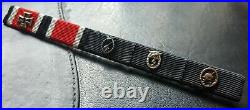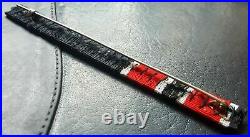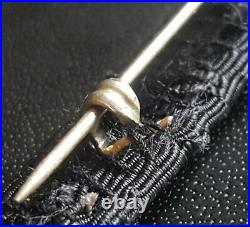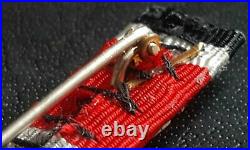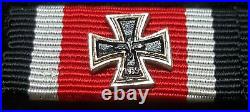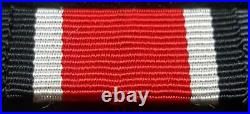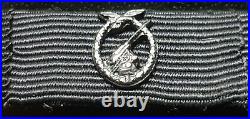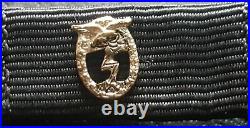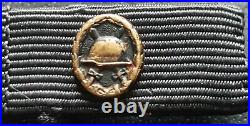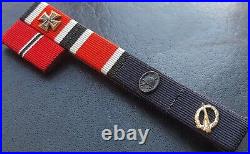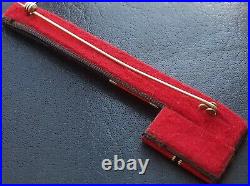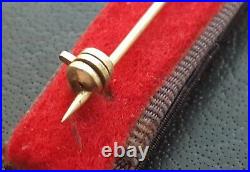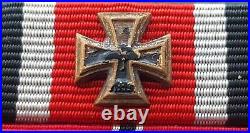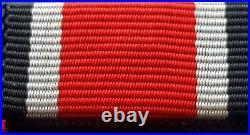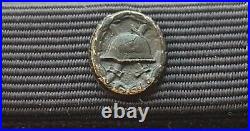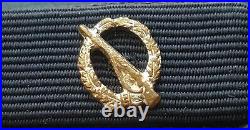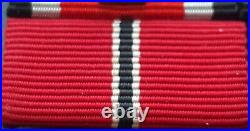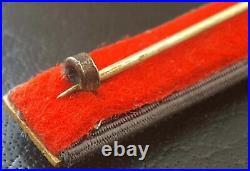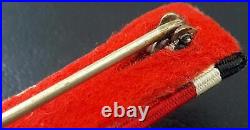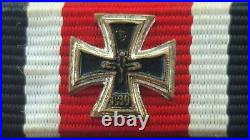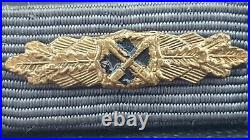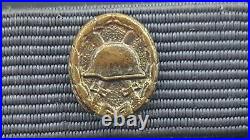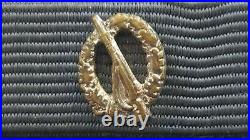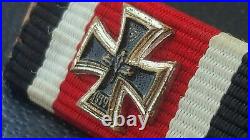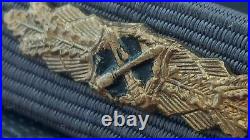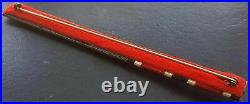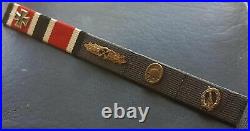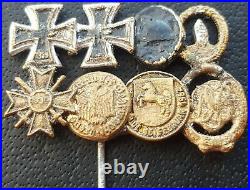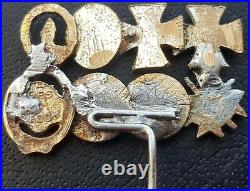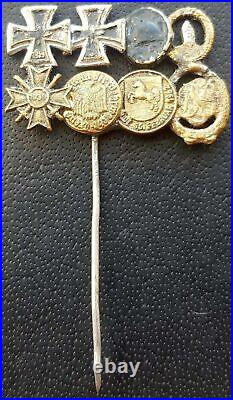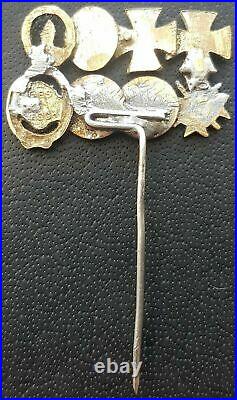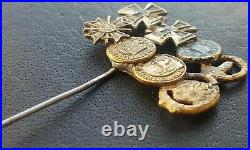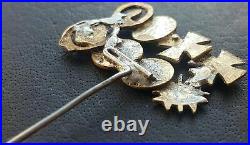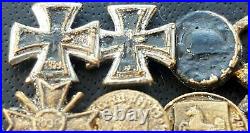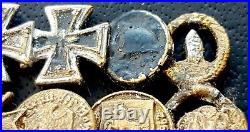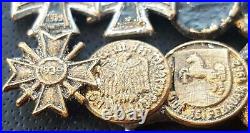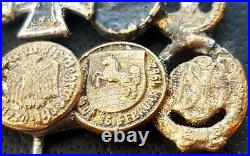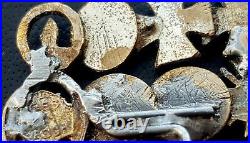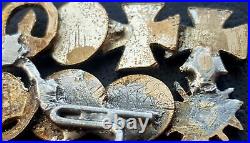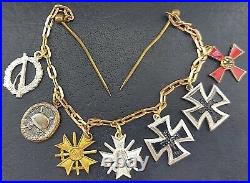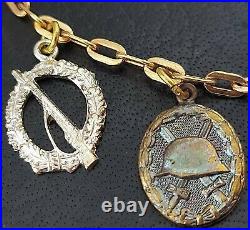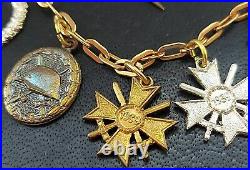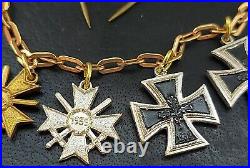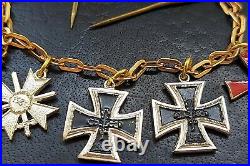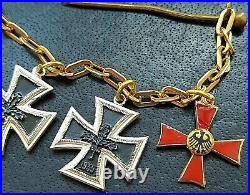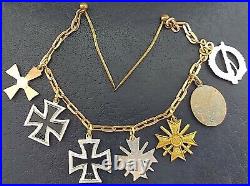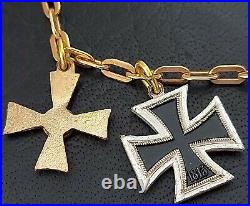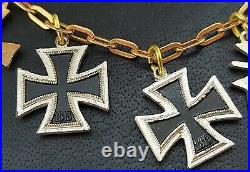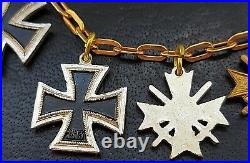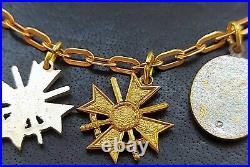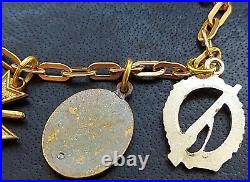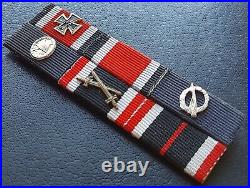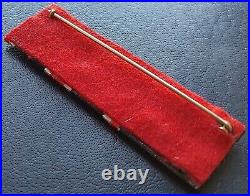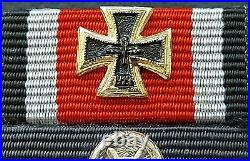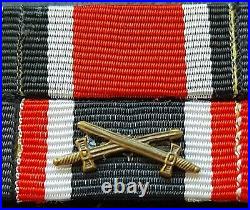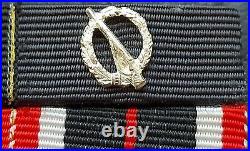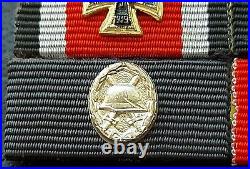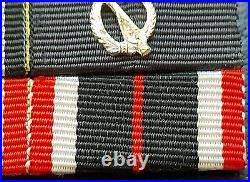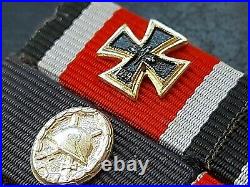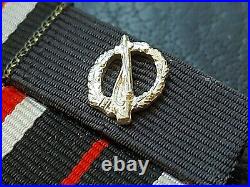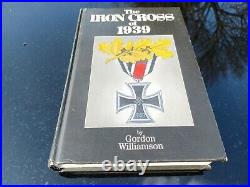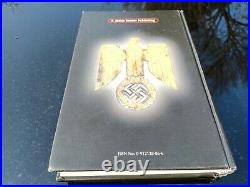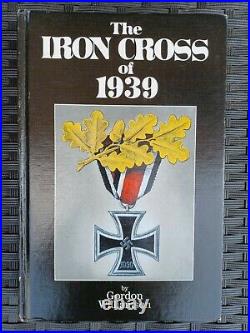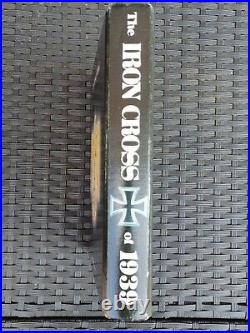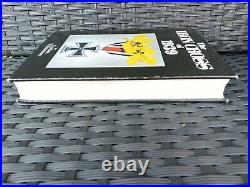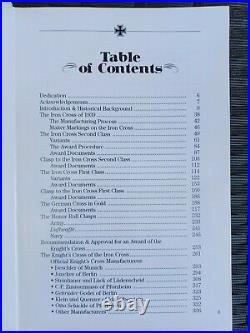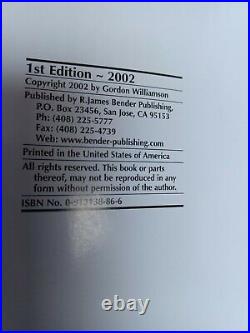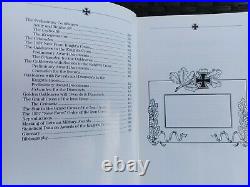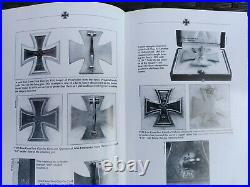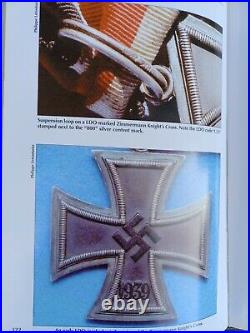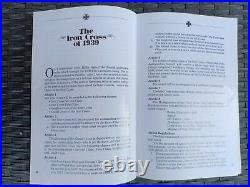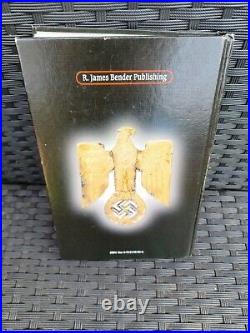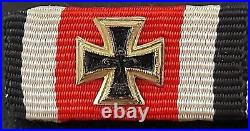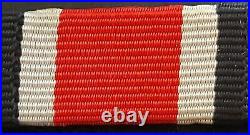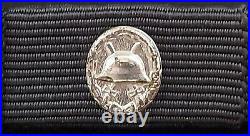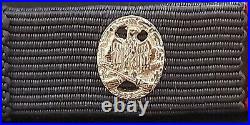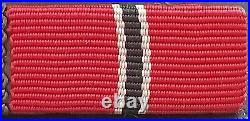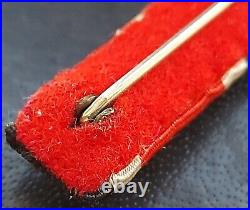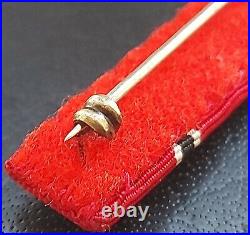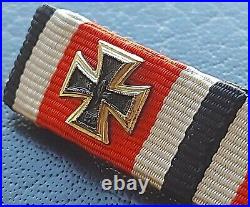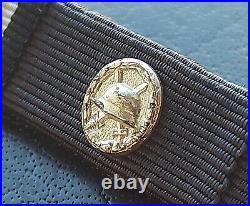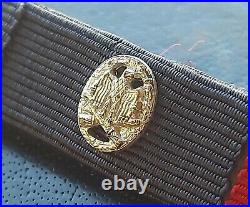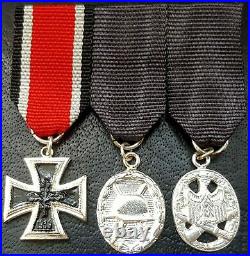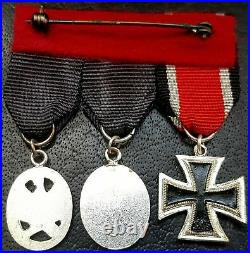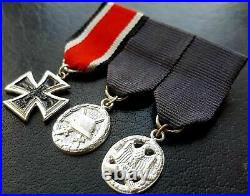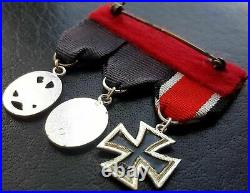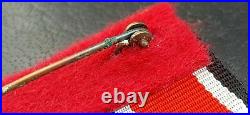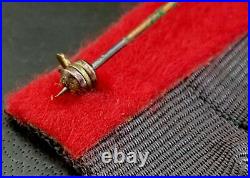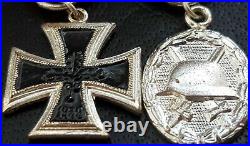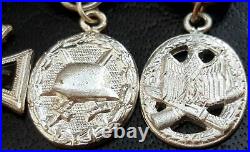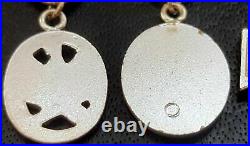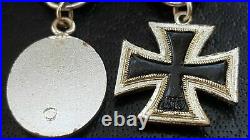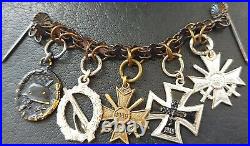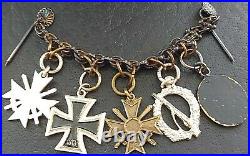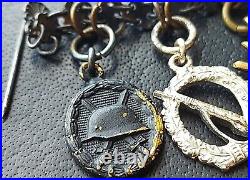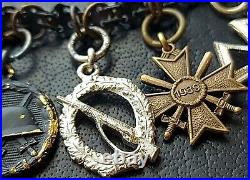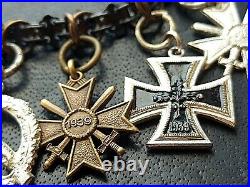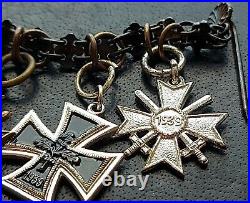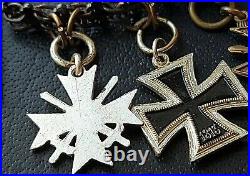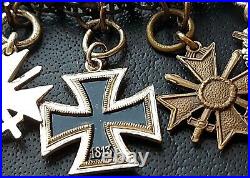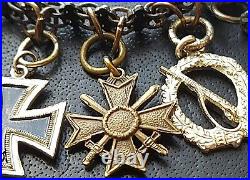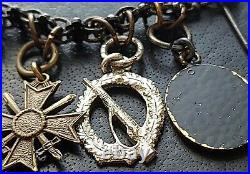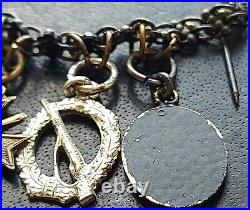Original German post WW2 (1957 pattern) miniatures on chain: Order of Merit Cross II. Class, Iron Cross First Class, Iron Cross II. Class, War Merit Cross With Swords First Class, War Merit Cross With Swords II. Class, Wound Badge in Black & Infantry Assault Badge in Silver, IN VERY GOOD CONDITION – THE ORDER OF MERIT SEEMS REPAIRED, FINE DETAILED EXAMPLES ON ATTRACTIVE CHAIN, SIZE OF EACH MINIATURES: cca 16 mm. FEW FACTS ABOUT 1957 PATTERN AWARDS. In 1957 the West German government authorised replacement Iron Crosses with an Oak Leaf Cluster in place of the swastika, similar to the Iron Crosses of 1813, 1870, and 1914, which could be worn by World War II Iron Cross recipients. The 1957 law also authorised de-Nazified versions of most other World War II-era decorations (except those specifically associated with Nazi Party organizations, such as SS Long Service medals, or with the expansion of the German Reich, such as the medals for the annexation of Austria, the Sudetenland, and the Memel region). The main government contract to manufacture and supply these new de-nazified WW2 1957 official decorations went to the world famous German firm Steinhauer & Lueck, Luedenscheid Germany. Knights Crosses, Iron Crosses, Wound Badges, Tank Assault Badges etc were re-designed by Steinhauer & Lück – often with the oak-leaf spray replacing the swastika, with S&L having the sole patent rights to all WW2 1957 German decorations. S&L did not have the whole monopoly on medal making, other famous firms such as Deschler & Sohn, BH Maher and Juncker also manufactured these new German decorations. Lüdenscheid is situated between the cities Dortmund and Bonn. It was here that one of the youngest medal firms was founded in 1889 by August Steinhauer and Gustav Adolf Lück. The first production began in a cellar, the customer base continued to increase. A property was bought at 51 Hochstrasse which is still home for this famous company today. During WW2 Steinhauer & Lück produced medals and badges, like the famous Knights Cross and many other types of medals and badges. In 1957 this company was awarded the contract to produce all the newly re-designed legal WW2 1957 de-nazified decorations, plus the contract to manufacture all of Germany’s official decorations including Germany’s highest order the Bundesverdienstkreuz. Only a very limited number of original WW2 1957 medals are still produced, mainly Iron Crosses, German Cross Gold & Silver & Wound Badges and are considered 100% genuine by the German Government. HISTORY OF THE AWARD. The Order of Merit of the Federal Republic of Germany (Verdienstorden der Bundesrepublik Deutschland) is the only federal decoration of Germany. It was created by the first President of the Federal Republic of Germany, Theodor Heuss, on 7 September 1951. Colloquially, the decorations of the different classes of the Order are also known as Federal Cross of Merit (German: Bundesverdienstkreuz). Most of the German federal states (Länder) have each their own order of merit as well, with the exception of the Free and Hanseatic Cities of Bremen and Hamburg, which reject any orders by old tradition their citizens, particularly former or present senators, will refuse any decoration in the form of an order. Most famous example: former Chancellor Helmut Schmidt. The order was established on 7 September 1951 by the decree of the then Federal President Theodor Heuss. The decree, which was co-signed by the President Heuss together with Chancellor Konrad Adenauer and the Minister of the Interior, Robert Lehr, signed, states: Bring Desiring deserved men and women of the German people and of foreign recognition and thanks to the visible expression, I record on 2 Anniversary of the Federal Republic of Germany the Order of Merit of the Federal Republic of Germany. It is awarded for achievements that served the reconstruction of the country in the political, socio-economic and intellectual work, and is intended to mean an award of all those whose work contributes to the peaceful rise of the Federal Republic of Germany. The Order comprises four groups with in total eight classes: Grand Cross (Großkreuz), Grand Cross Special Class (Sonderstufe des Großkreuzes), Grand Cross 1st Class (Großkreuz), sometimes with laurel wreath (special design; Großkreuz besonderer Ausführung), Grand Merit Cross (Großes Verdienstkreuz), Grand Cross 2nd Class, or Grand Merit Cross with Star and Sash (Großes Verdienstkreuz mit Stern und Schulterband), Grand Officer’s Cross, or Grand Merit Cross with Star (Großes Verdienstkreuz mit Stern), Commander’s Cross, or Grand Merit Cross (Großes Verdienstkreuz), Merit Cross (Verdienstkreuz), Officer’s Cross, or Merit Cross 1st Class Verdienstkreuz 1. The President of the Federal Republic holds the Grand Cross Special Class ex officio. It is awarded to him in a ceremony by the President of the Bundestag, attended by the Chancellor of Germany, the President of the Bundesrat, and the Supreme Court President. Other than the German president, only a foreign head of state can be awarded with this highest class. There is also the provision of awarding the Grand Cross 1st Class in a special rare design, in which the central medallion with the black eagle is surrounded by a stylized laurel wreath in relief. This Grand Cross special design has been awarded so far only twice, to former German chancellors Konrad Adenauer and Helmut Kohl. Except for the lowest class, the badge is the same for all classes, but with slightly different versions for men and women (slightly smaller badge and ribbon for women): the badge is a golden Cross enamelled in red, with a central disc bearing a black eagle. The star is a golden star with straight rays, its size and points vary according to class, with the badge superimposed upon it. 8-pointed golden Star : Grand Cross Special Class, 6-pointed golden Star : Grand Cross 1st Class (with special design if golden oak crown between the cross branches around the medallion), 4-pointed golden Star : Grand Cross 2nd Class (Grand Merit Cross with Star and Sash) silver Square-upon-point : Grand Officer (Grand Merit Cross with Star). The ribbon is red with gold-black-gold stripes. Iron Cross (German: Eisernes Kreuz) was a military decoration of the Kingdom of Prussia, and later of Germany, which was established by King Friedrich Wilhelm III of Prussia and first awarded on 10 March 1813 in Breslau. In addition to during the Napoleonic Wars, the Iron Cross was awarded during the Franco-German War, the First World War, and the Second World War. The Iron Cross was normally a military decoration only, though there were instances of it being awarded to civilians for performing military functions. Two examples, the civilian pilot Hanna Reitsch was awarded the Iron Cross First Class for her bravery as a test pilot during the Second World War and Melitta Schenk Gräfin von Stauffenberg (also a German female test pilot) was awarded the Iron Cross Second Class. The Iron Cross was also used as the symbol of the German Army from 1871 to 1915, when it was replaced by a simpler Greek cross. In 1956, the Iron Cross became the symbol of the Bundeswehr, the German armed forces. The traditional design is black and this design is used on armored vehicles and aircraft. A newer design in blue and silver is used as the emblem in other contexts. The Iron Cross is a black four-pointed cross with white trim, with the arms widening towards the ends, similar to a cross pattée. It was designed by the neoclassical architect Karl Friedrich Schinkel and reflects the cross borne by the Teutonic Knights in the 14th century. The ribbon for the 1813, 1870 and 1914 Iron Cross (2nd Class) was black with two thin white bands, the colours of Prussia. The noncombatant version of this award had the same medal, but the black and white colours on the ribbon were reversed. Initially the Iron Cross was worn with the blank side out. This did not change until 1838 when the sprig facing could be presented. Since the Iron Cross was issued over several different periods of German history, it was annotated with the year indicating the era in which it was issued. For example, an Iron Cross from the First World War bears the year “1914″, while the same decoration from the Second World War is annotated “1939″. The reverse of the 1870, 1914 and 1939 series of Iron Crosses have the year “1813″ appearing on the lower arm, symbolizing the year the award was created. The 1813 decoration also has the initials “FW” for King Frederick William III, while the next two have a “W” for the respective kaisers, Wilhelm I and Wilhelm II. The final version shows a swastika. It was also possible for a holder of the 1914 Iron Cross to be awarded a second or higher grade of the 1939 Iron Cross. In such cases, a “1939 Clasp” (Spange) would be worn on the original 1914 Iron Cross. A similar award was made in 1914 but was quite rare, since there were few in service who held the 1870 Iron Cross. For the First Class award the Spange appears as an eagle with the date “1939″ that was pinned above the Cross. Although two separate awards, in some cases the holders soldered them together. A cross was the symbol of the Teutonic Knights (a heraldic cross pattée), and the cross design (but not the specific decoration) has been the symbol of Germany’s armed forces (now the Bundeswehr) since 1871. The Iron Cross was founded on 10 March 1813 in Breslau and awarded to soldiers during the Wars of Liberation against Napoleon. It was first awarded to Karl August Ferdinand von Borcke on 21 April 1813. King Wilhelm I of Prussia authorized further awards on 19 July 1870, during the Franco-German War. The Iron Cross was reauthorized by Emperor Wilhelm II on 5 August 1914, at the start of the First World War. During these three periods, the Iron Cross was an award of the Kingdom of Prussia, although given Prussia’s pre-eminent place in the German Empire formed in 1871, it tended to be treated as a generic German decoration. The 1813, 1870, and 1914 Iron Crosses had three grades: Iron Cross 2nd Class German: Eisernes Kreuz 2. Klasse, Iron Cross 1st Class German: Eisernes Kreuz 1. Klasse, Grand Cross of the Iron Cross (German: Großkreuz des Eisernen Kreuzes, often simply Großkreuz). Although the medals of each class were identical, the manner in which each was worn differed. Employing a pin or screw posts on the back of the medal, the Iron Cross First Class was worn on the left side of the recipient’s uniform. The Grand Cross and the Iron Cross Second Class were suspended from different ribbons. The Grand Cross was intended for senior generals of the German Army. An even higher decoration, the Star of the Grand Cross of the Iron Cross, was awarded only twice, to Field Marshal Gebhard von Blücher in 1813 and to Field Marshal Paul von Hindenburg in 1918. A third award was planned for the most successful German general during the Second World War, but was not made after the defeat of Germany in 1945. The Iron Cross 1st Class and the Iron Cross 2nd Class were awarded without regard to rank. One had to already possess the 2nd Class in order to receive the 1st Class (though in some cases both could be awarded simultaneously). The egalitarian nature of this award contrasted with those of most other German states (and indeed many other European monarchies), where military decorations were awarded based on the rank of the recipient. For example, Bavarian officers received various grades of that Kingdom’s Military Merit Order (Militär-Verdienstorden), while enlisted men received various grades of the Military Merit Cross (Militär-Verdienstkreuz). Prussia did have other orders and medals which were awarded on the basis of rank, and even though the Iron Cross was intended to be awarded without regard to rank, officers and NCOs were more likely to receive it than junior enlisted soldiers. In the First World War, approximately four million Iron Crosses of the lower grade (2nd Class) were issued, as well as around 145,000 of the higher grade (1st Class). Exact numbers of awards are not known, since the Prussian archives were destroyed during the Second World War. The multitude of awards reduced the status and reputation of the decoration. Among the holders of the 1914 Iron Cross 2nd Class and 1st Class was Adolf Hitler, who held the rank of Gefreiter. Hitler can be seen wearing the award on his left breast, as was standard, in many photographs. The straight-armed Balkenkreuz, the emblem of the Wehrmacht, first used in a narrower form on Luftstreitkräfte aircraft in mid-April 1918, and as shown here, as it appeared on German planes, tanks, and other vehicles during the Second World War. Adolf Hitler restored the Iron Cross in 1939 as a German decoration (rather than Prussian as in earlier versions), continuing the tradition of issuing it in various grades. Legally it is based on the enactment Reichsgesetzblatt I S. 1573 of 1 September 1939 Verordnung über die Erneuerung des Eisernen Kreuzes (Regulation for the Re-introduction of the Iron Cross). The Iron Cross of the Second World War was divided into three main series of decorations with an intermediate category, the Knight’s Cross, instituted between the lowest, the Iron Cross, and the highest, the Grand Cross. The Knight’s Cross replaced the Prussian Pour le Mérite or “Blue Max”. Hitler did not care for the Pour le Mérite, as it was a Prussian order that could be awarded only to officers. The ribbon of the medal (2nd class and Knight’s Cross) was different from the earlier Iron Crosses in that the color red was used in addition to the traditional black and white (black and white were the colours of Prussia, while black, white, and red were the colors of Germany). Hitler also created the War Merit Cross as a replacement for the non-combatant version of the Iron Cross. It also appeared on certain Nazi flags in the upper left corner. The edges were curved, like most original iron crosses. The standard 1939 Iron Cross was issued in the following two grades: Iron Cross 2nd Class Eisernes Kreuz 2. Klasse, Iron Cross 1st Class Eisernes Kreuz 1. Klasse abbreviated as EKI or E. The Iron Cross was awarded for bravery in battle as well as other military contributions in a battlefield environment. The Iron Cross 2nd Class came with a ribbon and was worn in one of two different methods: when in formal dress, the entire cross was worn mounted alone or as part of a medal bar, for everyday wear, only the ribbon was worn from the second hole in the tunic button. The Iron Cross First Class was a pin-on medal with no ribbon and was worn centered on a uniform breast pocket, either on dress uniforms or everyday outfit. It was a progressive award, with the second class having to be earned before the first class and so on for the higher degrees. It is estimated that some four and a half million Second Class Iron Crosses were awarded in the Second World War, and 300,000 of the First Class. The War Merit Cross (Kriegsverdienstkreuz) and War Merit Medal (Kriegsverdienstmedaille) was a decoration of Nazi Germany during the Second World War, which could be awarded to civilians as well as military personnel. It was reissued in 1957 by the Bundeswehr in a De-Nazified version for veterans. This award was created by Adolf Hitler in 1939 as a successor to the non-combatant Iron Cross which was used in earlier wars (same medal but with a different ribbon). The award was graded the same as the Iron Cross: War Merit Cross Second Class, War Merit Cross First Class, and Knights Cross of the War Merit Cross. The award had two variants: with swords given to soldiers for exceptional service in battle above and beyond the call of duty (but not worthy of an Iron Cross which was more a bravery award), and without swords for meritorious service behind the lines which could also be awarded to civilians. Recipients had to have the lower grade of the award before getting the next level. There was also another version below the 2nd class simply called the War Merit Medal (German: Kriegsverdienstmedaille), set up in 1940 for civilians in order to offset the large number of 2nd class without swords being awarded. It was usually given to those workers in factories who significantly exceeded work quotas. One notable winner of the War Merit Cross was William Joyce (aka Lord Haw-Haw) who received both the second and first class, both without swords. Recipients of the Knights Cross of the War Merit Cross customarily received the medal from holders of the Knights Cross of the Iron Cross, to symbolize the link between the combat soldier and their supporters, who helped maintain the war effort. There was one extra grade of the War Merit Cross, which was created at the suggestion of Albert Speer: The Knights Cross of the War Merit Cross in Gold, but this was never officially placed on the list of national awards as it came about in 1945 and there was no time to officially promulgate the award before the war ended. The Knights Cross of the War Merit Cross in Gold (without swords) was awarded’on paper’ to two recipients on 20 April 1945: Franz Hahne and Karl-Otto Saur. The ribbon of the War Merit Cross was in red-white-black-white-red; that was, the red and black colors being reversed from the ribbon of the World War II version of the Iron Cross. The ribbon for the War Merit Medal was similar, but with a narrow red vertical red strip in the center of the black field. Soldiers who earned the War Merit Cross 2nd Class with Swords wore a small crossed-swords device on the ribbon. The War Merit Cross 1st Class was a pin-backed medal worn on the pocket of the tunic (like the Iron Cross 1st Class). The ribbon of the War Merit Cross 2nd Class could be worn like the ribbon of the Iron Cross 2nd Class (through the third buttonhole). Combat soldiers tended to hold the War Merit Cross in low regard, referring to its wearers as being in’Iron Cross Training’, and prior to 28 September 1941, the War Merit Cross could not be worn with a corresponding grade of the Iron Cross, which took precedence. A total of 118 awards of the Knights Cross of the War Merit Cross with swords, and 137 awards of the Knights Cross of the War Merit Cross without swords were awarded. Considering the relative rarity of the award compared with the grades of the Knights Cross of the Iron Cross, it took on extra meaning. For example, Reichsmarschall Hermann Göring made a concerted effort to get Hitler to award him this order, much to Hitler’s annoyance. In response, Hitler outlined a series of criteria governing the awarding of this decoration and the philosophy of such awards, and directed that “prominent party comrades” were not to be awarded with the Knights Cross of the War Merit Cross (or similar decorations), and withdrew the proposed awards of this order to Gauleiter Erich Koch and State Secretary Karl Hanke. Directing his comments at Göring personally, Hitler ordered that such attempts to gain this award be stopped (from a letter dated 27 August 1943 from Führerhauptquartier). Also, the scarcity of the award of the Knights Cross of the War Merit Cross compared with the Kinghts Cross of the Iron Cross gave it an “air of exclusiveness” it did not really deserve, as it ranked below the Knights Cross of the Iron Cross. Six persons received two Knights Cross’ of the War Merit Cross (one with Swords and one without Swords): Walter Brugmann, Julius Dorpmuller, Karl-Otto Saur, Albin Sawatzki, Walter Schreiber, and Walter Rohlandt. Wound Badge (German: das Verwundetenabzeichen) was a German military award for wounded or frost-bitten soldiers of Imperial German Army in World War I, the Reichswehr between the wars, and the Wehrmacht, SS and the auxiliary service organizations during the Second World War. After March 1943, due to the increasing number of Allied bombings, it was also awarded to injured civilians. It was ultimately one of the most common of all Third Reich decorations, yet also one of the most highly prized, since it had to be “bought with blood”. The badge had three versions: black (representing Iron), for those wounded once or twice by hostile action (including air raids), or frost-bitten in the line of duty; silver for being wounded three or four times, or suffering loss of a hand, foot or eye from hostile action (also partial loss of hearing), facial disfigurement or brain damage via hostile action; and in gold (which could be awarded posthumously) for five or more times wounded, total blindness, “loss of manhood”, or severe brain damage via hostile action. Badges exist in pressed steel, brass and zinc, as well as some base metal privately commissioned versions. Those of the First World War were also produced in a cutout pattern. All versions of the Wound Badge were worn on the lower left breast of the uniform or tunic. The badge was worn below all other awards on the left. It is thought that more than 5 million were awarded during World War II. In 1957, a revised version of the Wound Badge was authorised for wear; however, the previous type could still be worn if the swastika was removed (for example by grinding). The unaltered Second World War version is shown in the illustration to the right. Wound Badges were primarilly manufactured by the Vienna mint, and by the firm Klein & Quenzer. At first, the Wound badge in Black was stamped from sheet brass, painted semi-matt black, and had a hollow reverse with a needle pin attachment. From 1942, Steel was used to make the badges, which made them prone to rust. The Wound Badge in silver was made (before 1942) from silver-plated brass, and (after 1942) from laquered zinc, and had a solid reverse with either a needle pin or a broad flat pin bar. The Wound Badge in Gold was a gilded version of the Wound Badge in Silver. Heer Infantry Combat Badge, more commonly referred to as the Infantry Assault Badge, was designed by C. Junker of Berlin and instituted on December 20, 1939 by Generaloberst von Brauchitsch. The initial class was instituted in silver and decorated foot infantry who participated in combat action earning a degree of experience that qualified them for the badge. A separate class, in Bronze, was instituted on June 1, 1940. The Bronzed class had criteria similar to the requirements the Silver. There was, however, one notable distinction; The status of the troops, bronzed meant motorized Panzer troops, silver meant foot infantry. The Infantry Assault Badge consists of an oval wreath of oak leaves, made up of four leaves on each side of the arch. Every oak leaf has two acorns, one on each side of the base of the leaf. Centered at the bottom of the badge is a ribbon tied around the wreath, with five raised pellets in a vertical position at the center of this ribbon. The Badges most distinguishable feature is the K98 rifle positioned diagonally across award. The butt of this rifle, positioned on the right, is slightly below the wreath. It leans to the left, with its fixed bayonet protruding through the last of the four oak leaves. The rifle sling forms a loop, hanging from the stock to the butt. Surmounting the wreath is the national emblem; an eagle with down swept wings clutching a swastika in its talons. The badge has intricate detailing from the eagle down to the bolt on the rifle. The Infantry Assault Badge measures 46mm across and was slightly convex with either a solid or hollow back, and could be die stamped or cast. The reverse had a vertical pin with a hinge that was attached to the back of the eagle, with a retaining “C” clip which retained the clip. The method of attachment for the clip varied, some were welded or soldered while others had a more elaborate scheme where the pin sits in a recessed location the edges of which are crimped in order to hold the hinge in place (pictured above in the Bronzed version). The award was also available in a lapel pin miniature version to be worn whilst in civilian clothing. This item is in the category “Collectables\Militaria\World War II (1939-1945)\Medals/ Ribbons”. The seller is “a..anderson” and is located in this country: GB. This item can be shipped worldwide.
- Country/Region of Manufacture: Germany
- Country/ Organization: Germany
- Theme: Militaria
- Featured Refinements: Miniature Medal
- Type: Medals & Ribbons
- Conflict: World War II (1939-1945)
- Service: Army
- Era: 1945-Present


